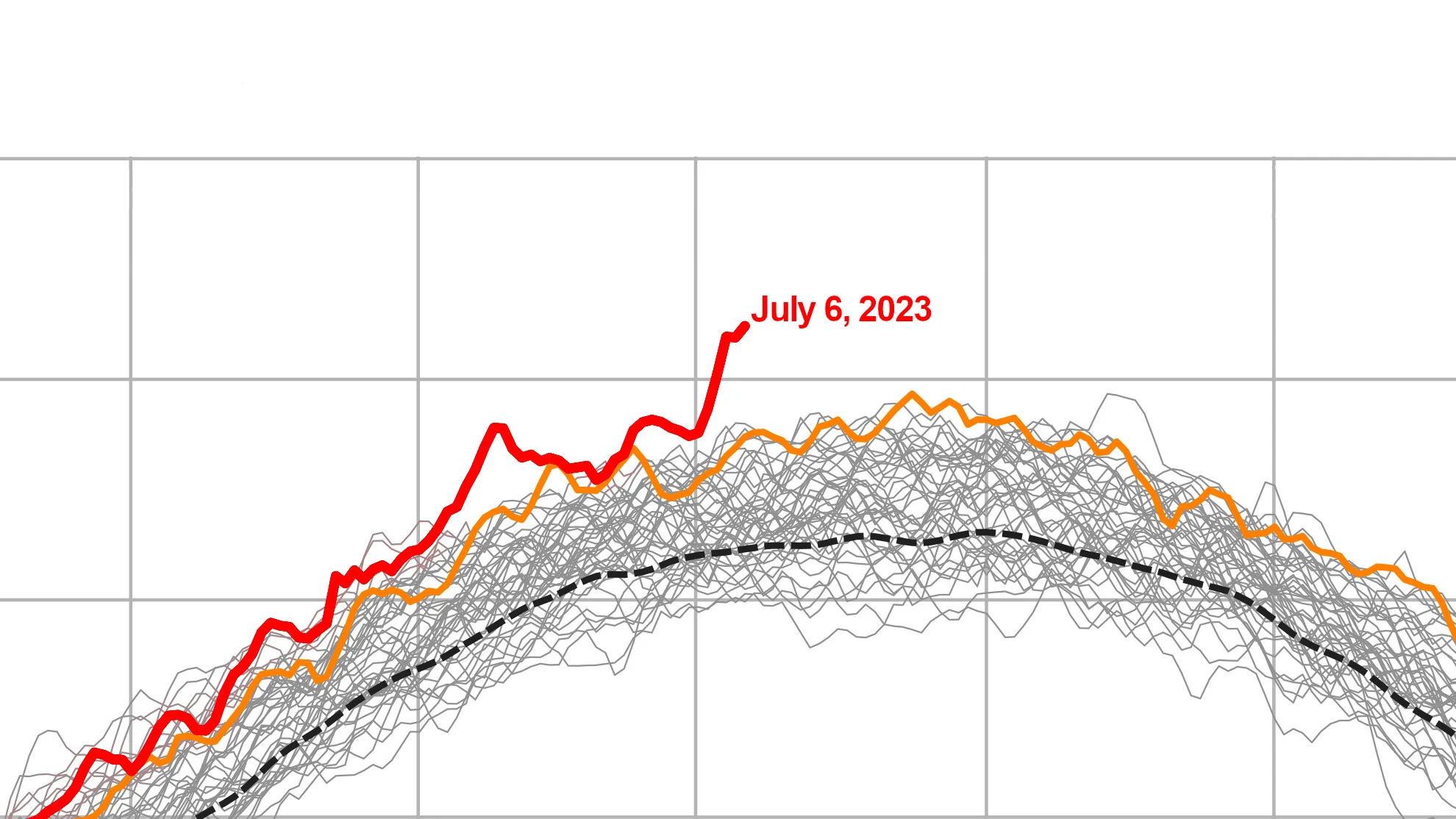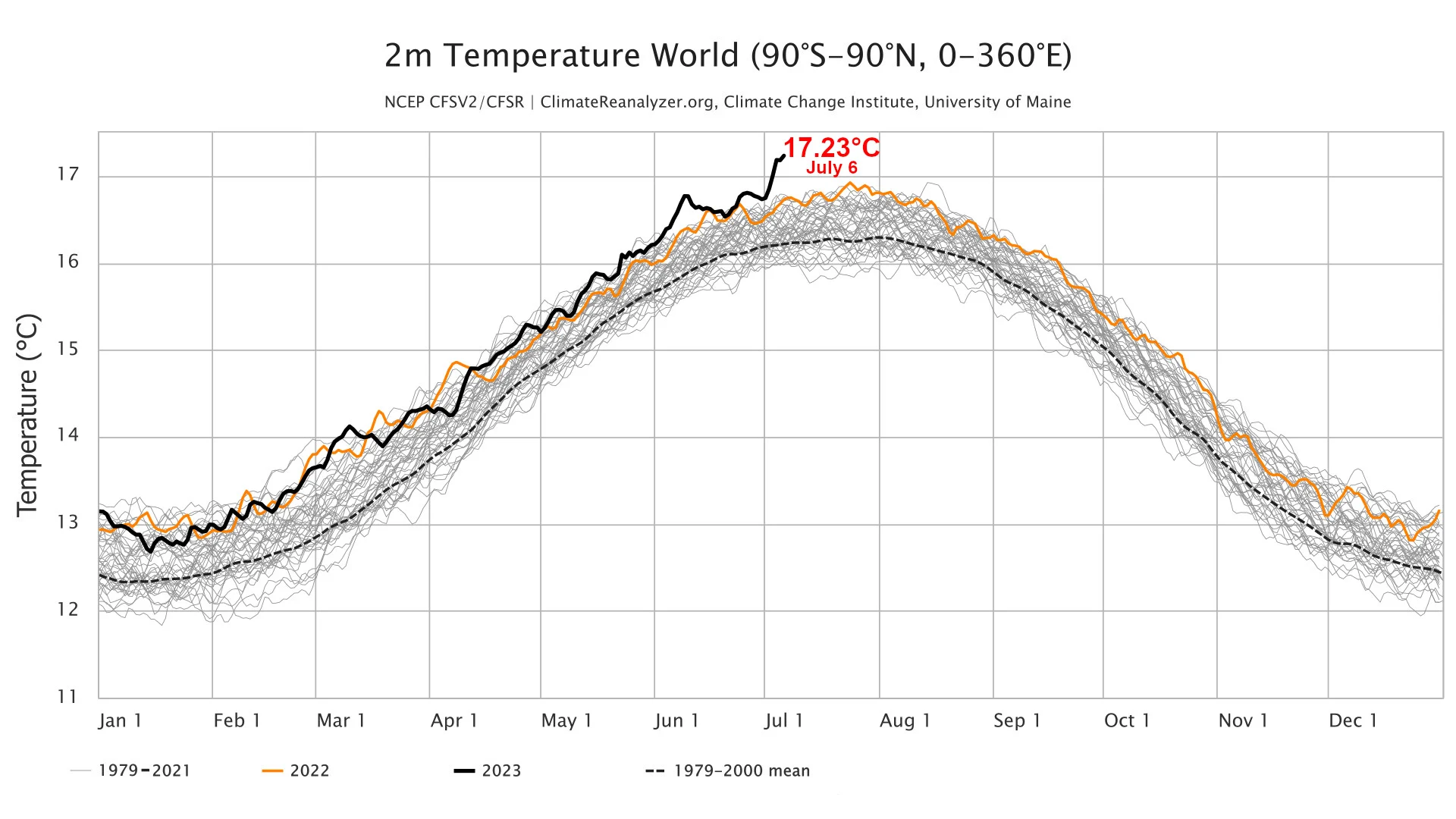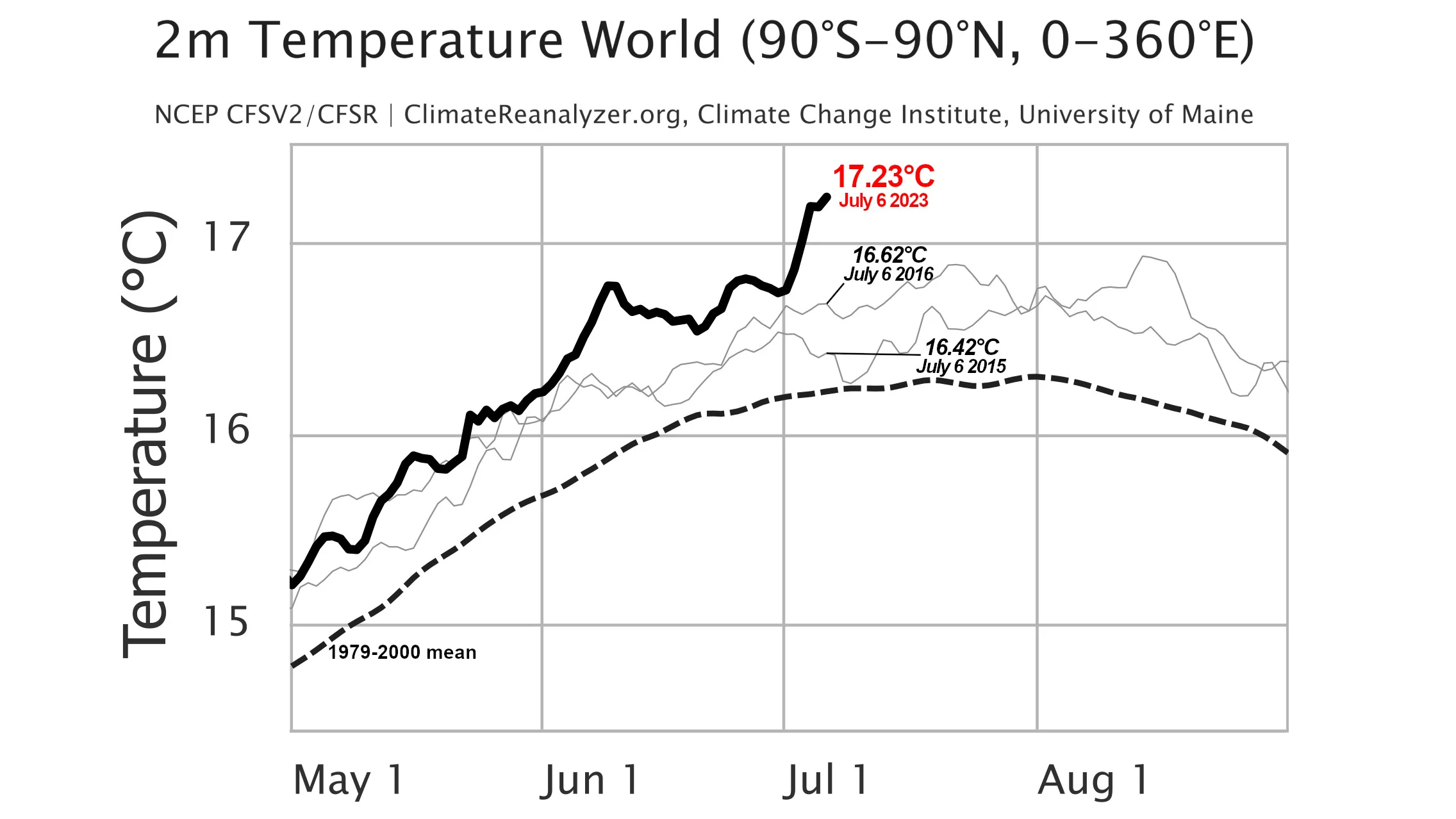
How have emissions contributed to the current heat records?
It’s summer, there’s a new El Niño, and there’s less air pollution in our skies, but how much does that weigh in against human-caused climate change when it comes to extreme global temperatures?
Since the start of July, global temperatures have soared, breaking all previous daily records. How much of this heat can be attributed to greenhouse gas emissions?
On Monday, July 3, the average temperature of the globe was recorded at just over 17°C. According to multiple sources, this was the hottest average global daily temperature ever recorded. Subsequently, on Tuesday and Wednesday, the temperature of the planet rose to an average of nearly 17.2°C, and on Thursday it spiked even higher.

This graph of global surface temperatures shows how hot it has been in 2023 so far (heavy black line) compared to previous years going back to 1979. The dashed line is the 1979-2000 average. (Birkel, S.D. 'Daily 2-meter Air Temperature', Climate Reanalyzer (https://ClimateReanalyzer.org), Climate Change Institute, University of Maine, USA. Accessed on July 7, 2023.)
READ MORE: Earth, Canada's North shatter temperature records as heat skyrockets
There is more than one factor contributing to these extreme temperatures.
Taking the temperatures themselves into consideration, rather than how extreme they are compared to previous records, the time of year plays a role. Even though the above graph plots global temperatures, it clearly follows a pattern similar to the northern hemisphere seasons.
This is due to the differences in landmass versus ocean surface between the two hemispheres. If the distribution was even across the entire planet, temperatures in the north and south would effectively balance each other, and a plot of seasonal global temperatures would be roughly a straight line across the graph.
However, with more land in the north, summer and winter temperatures reach greater extremes of hot and cold, respectively. In the south, the larger ocean surface keeps temperatures more moderate. So, when everything is added up, northern hemisphere temperatures dominate.
Given that these latest extreme temperatures are so much higher than previous records, though, it isn’t just the seasonal cycle. There is obviously something else going on here.
El Niño + greenhouse gas emissions = trouble
El Niño is another factor. We’ve had over two years of La Niña conditions in the equatorial Pacific Ocean. This kept overall global temperatures on the cool side during that time. Now that El Niño has returned, the planet will trend warmer again. Still, during the last El Nino, back in 2015-2016, the globe was at least half a degree Celsius cooler than it is now.

This graph shows July 6, 2023 global temperature vs the same day in the El Niño years of 2016 and 2015, with all compared to the 1979-2000 average. (Climate Reanalyzer/Scott Sutherland)
So, while El Niño is contributing, there’s definitely more to it.
Despite it being summer now in the northern hemisphere, and in the early stages of a new El Niño pattern, the main culprit for these extreme temperatures is still human-caused climate change — specifically due to the emission of carbon dioxide and other greenhouse gases.
According to Zeke Hausfather, a researcher at Berkeley Earth, “while the warming we see is well within the range of what our climate models expect, models show a near-term acceleration of warming if we do not reduce emissions.”
So far in 2023, monthly global temperatures have been on the rise, with May of this year ranking as the hottest month of May on record. Last month apparently also ranked as the warmest June on record, says the World Meteorological Organization.
NOAA scientists were already giving this year a 90 per cent chance of ending up in the top five warmest years on record, and a 50-50 chance of being in the top three. More temperature records like this will undoubtedly increase the odds of 2023 ranking even higher on that list.
"Unfortunately, it promises to only be the first in a series of new records set this year as increasing emissions of [carbon dioxide] and greenhouse gases coupled with a growing El Niño event push temperatures to new highs," Hausfather said according to Reuters.
Cleaner skies, warmer planet
One relatively new factor to consider is low-sulphur fuels for ocean-going vessels.
Sulphur emissions from international shipping had been on the rise for decades, simply due to the increasing number of ships traversing the oceans. Since 2008, though, they have been on a general downward trend after regulations reduced the sulphur content in fuels. They then dropped precipitously in 2020, when the shipping industry completely phased out sulphur in ship fuels.

Global SO2 emissions from international shipping from the global aerosol dataset (CEDS) (1970-2019). Estimates thereafter by Leon Simons based on projected effects of low-sulphur fuel regulations introduced in 2020. (Zeke Hausfather/Carbon Brief)
The byproduct of burning these fuels was sulphur dioxide gas being emitted into the environment. Sulphur dioxide (SO2) is a toxic air pollutant and also one of the main causes of acid rain. It also has an impact on the climate.
“SO2 has a strong cooling effect on the climate, both through directly reflecting incoming sunlight and by acting as cloud condensation nuclei. This increases the formation of reflective clouds,” Dr. Zeke Hausfather and Prof. Piers Forster wrote on CarbonBrief.
“Given the strong cooling impact of SO2, a 10% reduction in emissions of SO2 will result in additional global warming,” they explained.
After their analysis, Hausfather and Forster determined that, this soon after the phase-out, the contribution to global temperatures was likely “in the hundredths of a degree globally.”
With the current extreme heat roughly two-tenths of a degree above recent years, that’s an order of magnitude larger than the potential contribution from the reduction in sulphur dioxide. As time goes on, though, the contribution from this will increase, with Hausfather and Forster stating that it would likely add about 0.05°C to global temperatures by 2050.
“This is equivalent to approximately two additional years of emissions,” they said.
(Thumbnail courtesy Birkel, S.D. 'Daily 2-meter Air Temperature', Climate Reanalyzer (https://ClimateReanalyzer.org), Climate Change Institute, University of Maine, USA. Accessed on July 7, 2023)











